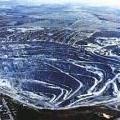 Since about the 1870s, the inhabitants of this area, some twenty kilometres northeast of Richmond, were aware of the strange substance which veined the rocks on a hillside known as "Webb's Ledge." It was a Welsh miner named Evan Williams, who, visiting his parents in 1881, first identified the substance as the mineral asbestos, and recognized its commercial value.
Since about the 1870s, the inhabitants of this area, some twenty kilometres northeast of Richmond, were aware of the strange substance which veined the rocks on a hillside known as "Webb's Ledge." It was a Welsh miner named Evan Williams, who, visiting his parents in 1881, first identified the substance as the mineral asbestos, and recognized its commercial value.
Soon after, a gentleman-farmer, W. H. Jeffrey, put up the necessary funds to start a mine on the site. A royalty of $10 per ton of fiber produced during the summer and $5 per ton during the winter was paid to Webb. The rate of production rose from one to two tons per day to an annual rate of 2300 tons by 1895, and increased considerably more in the years to come.
Mining, at first, was primitive. Asbestos was blasted and dug out manually with chisels from a shallow open pit. The first derrick used to hoist the ore was powered by a single horse. Modern production methods are, of course, more sophisticated, and operations now extend far beneath the earth's surface in a network of underground mines.
 Over the years, the Jeffrey Mine has changed hands several times. It has experienced some serious economic downturns, not least of which was the result of a falling world demand for asbestos, brought on by perceived health risks associated with the mineral. Today, the mine is the property of JM Asbestos Inc. It has grown to over two kilometres in diametre, 350 metres in depth, and six square kilometres in total area, making it the largest open pit asbestos mine in the Western hemisphere.
Over the years, the Jeffrey Mine has changed hands several times. It has experienced some serious economic downturns, not least of which was the result of a falling world demand for asbestos, brought on by perceived health risks associated with the mineral. Today, the mine is the property of JM Asbestos Inc. It has grown to over two kilometres in diametre, 350 metres in depth, and six square kilometres in total area, making it the largest open pit asbestos mine in the Western hemisphere.
The Town of Asbestos, which has grown up alongside the huge mine, has had large chunks of its territory swallowed up by the expanding mine. Indeed, the downtown has disappeared several times over the years.